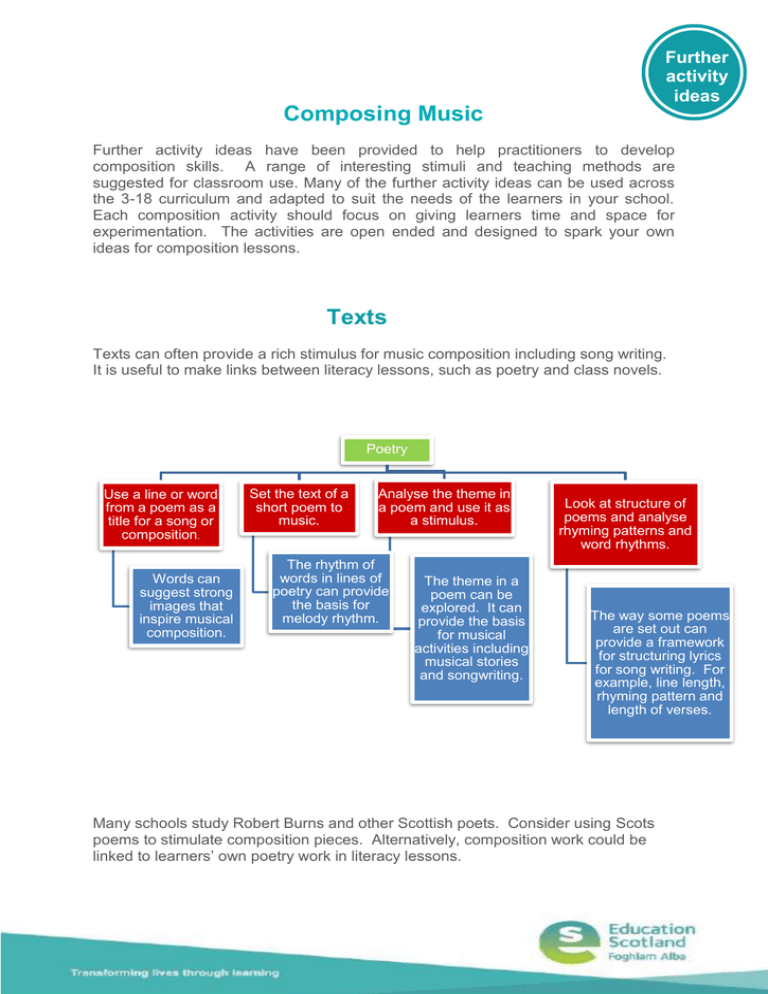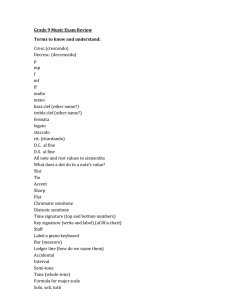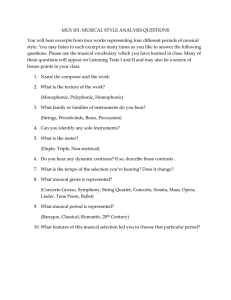Composing Music Further activity ideas
advertisement

Further activity ideas http://allpoetry.com/ Composing Music Further activity ideas have been provided to help practitioners to develop composition skills. A range of interesting stimuli and teaching methods are suggested for classroom use. Many of the further activity ideas can be used across the 3-18 curriculum and adapted to suit the needs of the learners in your school. Each composition activity should focus on giving learners time and space for experimentation. The activities are open ended and designed to spark your own ideas for composition lessons. Texts (Shiki) Texts can often provide a rich stimulus for music composition including song writing. It is useful to make links between literacy lessons, such as poetry and class novels. Poetry Use a line or word from a poem as a title for a song or composition. Words can suggest strong images that inspire musical composition. Set the text of a short poem to music. Analyse the theme in a poem and use it as a stimulus. The rhythm of words in lines of poetry can provide the basis for melody rhythm. The theme in a poem can be explored. It can provide the basis for musical activities including musical stories and songwriting. Look at structure of poems and analyse rhyming patterns and word rhythms. The way some poems are set out can provide a framework for structuring lyrics for song writing. For example, line length, rhyming pattern and length of verses. Many schools study Robert Burns and other Scottish poets. Consider using Scots poems to stimulate composition pieces. Alternatively, composition work could be linked to learners’ own poetry work in literacy lessons. Haiku Haiku poems can conjure up a whole host of images which could be used to inspire composition. Each of the examples below can provide a stimulus to explore contrasts in music, for example; harmonic, dynamic and rhythmic contrasts. Using Haiku or other stimuli to explore musical contrast can help learners build up an understanding of how these tensions in music can make a connection with listeners. Creating soundscapes (a free-form musical composition that might include recorded source sounds or music composed for instruments) can be a great way to explore musical elements. Practitioners should also consider using texts from other curricular areas to inspire composition, for example, a script from drama or a non-fiction text from social studies. In addition to focusing on their composition, learners will have the opportunity to reinforce learning from across the curriculum. Images Using images is a great way to spark imagination. They can be used in a number of different ways as contexts for learning. Below are two examples of how images can be used to inspire a creative response. The Quiraing, Skye These two images of Scottish landscape could be used, for example, to provoke thinking about urban and rural areas. This discussion could lead to identifying a variety of sounds to use as a basis for developing soundscapes or musical stories. Another way to use an image such as might be to use the shape of the skyline to give an outline shape to a musical element such as melody or dynamics. Edinburgh The next step is to superimpose the outline onto a musical stave. It can be moved around to provide a 'best fit'. The outline provides a number of 'hit points' on notes. These notes can then be explored further and shaped by experimenting with them in different ways until an idea is settled upon. This outline can be Used in a number of For example, roughly trace the outline of the skyline, which will help to give a ‘melodic shape’. This picture could p This outline could: provide overall structure to a piece. form a melodic shape over a bar or phrase of music. suggest how the dynamics of the piece might change over time. The next step is to superimpose the outline on to a musical stave. The outline will provide suggested notes for a melody. These notes can then be explored further and shaped by experimenting with them in different ways. For example, different scales (possibly of their own invention), rhythmic patterns. More advanced learners could explore mixed meters and a broad range of rhythmic divisions. Below is an example of how to use an outline to represent music dynamics. It could equally be used to explore a musical building block such as rhythm, with the length of the lines representing different note values, or exploring musical intervals (the distance between notes). The shape may also be used as a template for music dynamics. Dynamics Very loud – fortissimo – ff Loud – forte – f Medium loud – mezzo forte – mf Quiet – piano - p Very quiet – pianissimo - pp Time Here are some other suggestions for how images can inspire composition work. Nature Travel Landscape organic journey rugged cycle of life arrival isolated seasons motion dense floral patterns departure barren bird song destination mountainous Chords The following musical activities are intended to provide a stimulus based on a musical concept to begin the composition process. Some suggestions are more advanced than others. 12 bar blues music is often in 4/4 time and is mostly patterned on a 12-bar structure (although 8 and 16 bars are also found) and on a scale where some notes are flattened. I I I I IV IV I I V IV I I More examples of how to develop blues music can be found on the internet. Scales Below, some scales are exemplified for use in composition lessons. Learners should be encouraged to create their own scales. For example, ask learners to develop scales which consist of 6, 7, 8 or 9 notes. It is possible to have other pentatonic scales, which could be any collection of five notes. Encourage learners to explore the interval pattern as this is what defines the scale C Major: C D E F G A B C Tone Tone Semitone Tone Tone Tone Semitone Invented scale: C C# E G G# A# B Semitone Minor third Minor third Semitone Tone Semitone This is a useful way to develop interval awareness in learners by challenging them to create other interval patterns that use combinations of tones, semitones, and possible larger intervals like minor thirds, and then arrange them into ascending order. The pentatonic scale is a scale containing five notes. A large number of Scottish folk songs and tunes are based on the pentatonic scale. The whole tone scale is a scale containing no semitones but built entirely on whole tones. Debussy used the whole-tone scale in some of his pieces which were influenced by Impressionism. A whole-tone scale on C is shown below. The octatonic scale is a scale that has eight notes and is constructed from alternating semitones and tones. Here is an example of an octatonic scales starting on D. Mode There a number of different modes. Some of these were later refined into modern major and minor scale structures (Ionian mode is the modern day major scale). Like a scale, modes can be built on any note. One of the most common modes is the Dorian mode. It is formed using the following patterns: Here are other diatonic modes to explore. These can be transposed to any tonic (starting pitch). Phrygian Lydian Mixolydian Aeolian Locrian Rhythm A matrix, such as the one below, can be used to begin building rhythms. It can be used in the same way as a step sequencer in music technology. If there is a note in the box, play it, if the box is blank, take a rest. This rhythm matrix represents one bar of music. Each note in this matrix is equal to half a beat (a quaver). This is just a guide; a rhythmic matrix can cover as many bars as you require. The idea behind the matrix can be adjusted to suit your needs. When working with young children, the matrix could be set out in a 4 beat pattern. A more complex matrix could see each beat being subdivided into 4, giving a possible 16 note pattern. The next step is to begin populating the matrix with notes. These notes initially could be played using non-tuned percussion instruments, or body percussion, and then extended to tuned instruments. The matrix could be used to plot the rhythms of names or words which could then be plotted out to form individual rhythms for the pupils to play. Working in groups, the pupils could make up their own rhythms, add them to the matrix, decide on the instrument or body percussion, and then put it all together. Other links Primary composition TES – Primary music – composing lessons Teach Primary – KS2 Music: composing songs Primary Resources – Music resources Teaching Ideas – Composition Music Manifesto – Teaching composing at KS2 Learn Together – Primary music composing guidelines Music for Youth - composition Secondary composition Envatotuts+ - 11 ways to find immediate inspiration for your next composition Teaching Ideas – Composition TES Australia – Composing Share My Lesson – Composing and performing Interviews You may find inspiration from the links below to a range of composers and songwriters: Song writers: Beth Nielesen Chapman Lionel Ritchie Bruce Springsteen Sting Documentary Gary Barlow Composers: Composer circle Aaron Copeland Schoenberg




